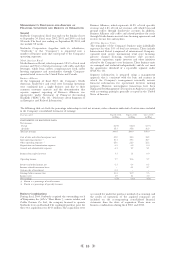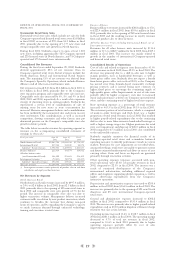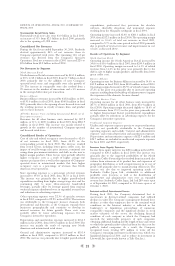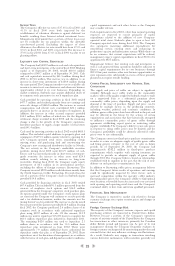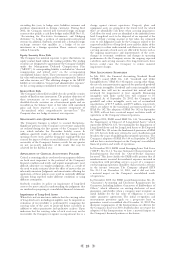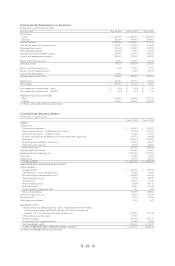Starbucks 2002 Annual Report Download
Download and view the complete annual report
Please find the complete 2002 Starbucks annual report below. You can navigate through the pages in the report by either clicking on the pages listed below, or by using the keyword search tool below to find specific information within the annual report.
15
CAUTIONARY STATEMENT PURSUANT TO THE PRIVATE
SECURITIES LITIGATION REFORM ACT OF 1995
Certain statements set forth in or incorporated by reference
into this Annual Report on Form 10-K, including anticipated
Company-operated and licensed store openings, planned
capital expenditures, expected cash requirements and trends
in or expectations regarding the Company’s operations,
constitute “forward-looking statements” within the meaning
of the Private Securities Litigation Reform Act of 1995. Such
statements are based on currently available operating, financial
and competitive information and are subject to various risks
and uncertainties. Actual future results and trends may differ
materially depending on a variety of factors, including, but not
limited to, coffee and other raw materials prices and
availability, successful execution of internal performance and
expansion plans, the effect of slowing United States and
international economies, the impact of competition, the effect
of legal proceedings and other risks detailed herein and in
Starbucks Corporation’s other filings with the Securities and
Exchange Commission.
BUSINESS
Starbucks Corporation (together with its subsidiaries,
“Starbucks” or the “Company”) purchases and roasts high-
quality whole bean coffees and sells them, along with fresh,
rich-brewed coffees, Italian-style espresso beverages, cold
blended beverages,a variety of pastries and confections, coffee-
related accessories and equipment, a selection of premium teas
and a line of compact discs primarily through Company-
operated retail stores. In addition, Starbucks sells coffee and tea
products through other channels of distribution, and, through
certain of its equity investees, Starbucks also produces and sells
bottled Frappuccino®and Starbucks DoubleShot™coffee
drinks and a line of premium ice creams. These non-retail
channels are collectively known as “Specialty Operations.”
The Company’s objective is to establish Starbucks as the most
recognized and respected brand in the world. To achieve this
goal, the Company plans to continue rapid expansion of its
retail operations, grow its Specialty Operations and selectively
pursue other opportunities to leverage the Starbucks brand
through the introduction of new products and the
development of new distribution channels.
Company-operated Retail Stores
The Company’s retail goal is to become the leading retailer
and brand of coffee in each of its target markets by selling the
finest quality coffee and related products and by providing
superior customer service, thereby building a high degree of
customer loyalty. Starbucks strategy for expanding its retail
business is to increase its market share in existing markets and
to open stores in new markets where the opportunity exists to
become the leading specialty coffee retailer. In support of this
strategy, Starbucks opened 614 new Company-operated stores
during the fiscal year ended September 29, 2002 (“fiscal
2002”). All store openings are reported net of closures. At
fiscal year end, Starbucks had 3,496 Company-operated stores
in 43 states, the District of Columbia and five Canadian
provinces (which comprise the Company’s North American
Retail operating segment), as well as 322 stores in the United
Kingdom, 33 stores in Australia and 29 stores in Thailand
(which comprise the Company’s International Retail business
unit). Company-operated retail stores accounted for
approximately 85% of net revenues during fiscal 2002.
Starbucks retail stores are typically located in high-traffic, high-
visibility locations. Because the Company can vary the size and
format, its stores are located in a variety of settings, including
downtown and suburban retail centers, office buildings and
university campuses. While the Company selectively locates
stores in suburban malls, it focuses on stores that have
convenient access for pedestrians and drivers.
All Starbucks stores offer a choice of regular and decaffeinated
coffee beverages, including at least one “coffee of the day,” a
broad selection of Italian-style espresso beverages, cold blended
beverages, a selection of teas and distinctively packaged roasted
whole bean coffees. Starbucks stores also offer a selection of
fresh pastries and other food items, sodas, juices, coffee-making
equipment and accessories, a selection of compact discs, games
and seasonal novelty items. Each Starbucks store varies its
product mix depending upon the size of the store and its
location. Larger stores carry a broad selection of the
Company’s whole bean coffees in various sizes and types of
packaging, as well as an assortment of coffee and espresso-
making equipment and accessories such as coffee grinders,
coffee makers, espresso machines, coffee filters, storage
containers, travel tumblers and mugs. Smaller Starbucks stores
and kiosks typically sell a full line of coffee beverages, a more
limited selection of whole bean coffees and a few accessories
such as travel tumblers and logo mugs. Approximately 500
Starbucks stores carry a selection of “grab and go” sandwiches
and salads. During fiscal 2002, the Company’s retail sales mix
by product type was approximately 77% beverages, 13% food
items, 6% whole bean coffees and 4% coffee-making
equipment and accessories.
Specialty Operations
Starbucks Specialty Operations strive to develop the Starbucks
brand outside the Company-operated retail store environment
through a number of channels. Starbucks strategy is to reach
customers where they work, travel, shop and dine by
establishing relationships with prominent third parties that
share the Company’s values and commitment to quality.These
relationships take various forms, including arrangements
through Business Alliances, international retail store licensing
agreements, grocery channel licensing agreements, warehouse
club accounts, interactive operations, equity investees and other
initiatives related to the Company’s core businesses. In certain
licensing situations, Starbucks has an equity ownership interest
in licensee operations. During fiscal 2002, specialty revenues
(which include royalties and fees from licensees as well as
product sales derived from Specialty Operations) accounted for
approximately 15% of the Company’s net revenues.
North American Foodservice Accounts and Retail Store
Licensing together comprise the Business Alliances operating
segment and represents approximately 45% of specialty revenues.
Foodservice Accounts
The Company sells whole bean and ground coffees to office
coffee distributors, hotels, airlines, retailers and restaurants as
well as institutional foodservice companies that service
business, industry, education and healthcare accounts. In fiscal
2002, the Company had approximately 5,600 foodservice
accounts, and revenues from these accounts comprised
approximately 27% of specialty revenues.
Retail Store Licensing
Although the Company does not generally relinquish
operational control of its retail stores in North America, in
situations in which a master concessionaire or another
company controls or can provide improved access to desirable
retail space, the Company licenses its operations. As part of
these arrangements, Starbucks receives license fees and royalties
and sells coffee and related products for resale in the licensed
locations. Employees working in the licensed locations must
follow Starbucks detailed store-operating procedures and
attend training classes similar to those given to Starbucks store
managers and employees. During fiscal 2002, Starbucks
opened 269 licensed retail stores. As of September 29, 2002,
the Company had 1,078 licensed stores in continental North
America. Revenues from these stores accounted for
approximately 18% of specialty revenues in fiscal 2002.
The remainder of the Company’s business units include
international retail store licensing, grocery channel licensing,
warehouse club accounts, interactive operations, equity
investees and other initiatives.These business units comprised
approximately 55% of specialty revenues in fiscal 2002.
International Retail Store Licensing
The Company’s retail stores located outside of North America,
the United Kingdom, Thailand and Australia are operated
through a number of licensing arrangements with prominent
retailers. During fiscal 2002, Starbucks expanded its
international presence by opening 294 new international
licensed stores, including the first stores in Austria, Oman,
Spain, Germany, Indonesia, Mexico, Puerto Rico and Greece.
Licensing arrangements are managed within three operating
Table of contents
-
Page 1
... its target markets by selling the finest quality coffee and related products and by providing superior customer service, thereby building a high degree of customer loyalty. Starbucks strategy for expanding its retail business is to increase its market share in existing markets and to open stores in... -
Page 2
... the grocery channel in the United States. Pursuant to that agreement, Kraft manages all distribution, marketing, advertising and promotions for Starbucks whole bean and ground coffee in grocery and mass merchandise stores and pays a royalty to Starbucks based on a percentage of total net sales. By... -
Page 3
... earnings per common share - diluted (5) Cash dividends per share BALANCE SHEET DATA Working capital Total assets Long-term debt (including current portion) Shareholders' equity STORE OPERATING DATA Percentage change in comparable store sales (6) North America International Consolidated $ 2,792,904... -
Page 4
... revenues, sells whole bean and ground coffees through foodservice accounts. In addition, Business Alliances sells coffee and related products for resale through North American retail store licensing agreements and receives license fees and royalties. All Other Business Units Starbucks Corporation... -
Page 5
... the continuing supply of high-quality green coffee. Improvements in cost of sales were partially offset by higher occupancy costs due to increased repair and maintenance activities on Company-operated retail stores and the continuing trend of higher retail rent expense. Net revenues increased 24... -
Page 6
...$ $ North American Retail $ 249,924 $ Business Alliances 43,777 All other business units 53,453 (130) Intersegment eliminations (1) 130 Unallocated corporate expenses (134,902) Operating income $ 212,252 $ (1) Intersegment eliminations consist primarily of product sales and related cost of sales to... -
Page 7
...a result of higher average rent expense per square foot as well as the expansion of Companyoperated stores in international markets that have higher occupancy costs as a percentage of revenues than North American retail operations. Operating income for all other business units increased by 28.7% to... -
Page 8
...cash resources to invest in its core businesses and other new business opportunities related to its core businesses. Depending on market conditions, Starbucks may acquire additional shares of its common stock pursuant to its stock repurchase plan. Cash provided by operating activities in fiscal 2002... -
Page 9
... 30, 2002 will not have a material impact on the Company's consolidated financial position and results of operations. In November 2001, FASB issued Emerging Issues Task Force ("EITF") No. 01-14, "Income Statement Characterization of Reimbursements Received for 'Out-of-Pocket' Expenses Incurred."This... -
Page 10
...0.24 371,191 385,999 CONSOLIDATED BALANCE SHEETS In thousands, except share data Sept 29, 2002 Sept 30, 2001 ASSETS Current assets: Cash and cash equivalents Short-term investments - Available-for-sale securities Short-term investments - Trading securities Accounts receivable, net of allowances of... -
Page 11
... Tax benefit from exercise of non-qualified stock options Cash provided/(used) by changes in operating assets and liabilities: Net purchases of trading securities Accounts receivable Inventories Prepaid expenses and other current assets Accounts payable Accrued compensation and related costs... -
Page 12
CONSOLIDATED STATEMENTS In thousands, except share data OF SHAREHOLDERS' EQUITY Additional Paid-In Capital Accumulated Other Comprehensive Income/(Loss) Common Stock Shares Amount Retained Earnings Total Balance, October 3, 1999 Net earnings Unrealized holding losses, net Translation ... -
Page 13
... management system provides for the reimbursement of all major bank disbursement accounts on a daily basis. Checks issued but not presented for payment to the bank are reflected as "Checks drawn in excess of bank balances" on the accompanying consolidated financial statements. Short-term Investments... -
Page 14
...guarantee agreements.The initial recognition and measurement Costs incurred in connection with the start-up and promotion of new store openings are expensed as incurred. Rent Expense Certain of the Company's lease agreements provide for scheduled rent increases during the lease terms or for rental... -
Page 15
... years' balances have been made to conform to the fiscal 2002 presentation. Note 2: Business Combinations During fiscal 2000, Starbucks acquired the outstanding stock of Tympanum, Inc. (d/b/a "Hear Music"), a music retailer, and Coffee Partners Co. Ltd., the company licensed to operate Starbucks... -
Page 16
... distributes premium ice creams. The Company is an equity owner in several other entities that operate licensed Starbucks retail stores, including Starbucks Coffee Japan, Ltd., Starbucks Coffee Korea Co., Ltd., and Coffee Partners Hawaii, a general partnership. On October 10, 2001, the Company sold... -
Page 17
...fiscal year 2002, the Company acquired 2.1 million shares at a cost of $42.0 million, leaving 7.9 million additional shares authorized for repurchase under this plan as of September 29, 2002. Comprehensive Income Note 10: Leases The Company leases retail stores, roasting and distribution facilities... -
Page 18
... with applicable tax laws in the United Kingdom. The employee's purchase price is 85% of the fair value of the stock on the first business day of a three-year offering period. No compensation expense was recorded in connection with the plan during fiscal 2002.The total number of shares issuable... -
Page 19
...tax assets: Equity and other investments Capital loss carryforwards Accrued occupancy costs Accrued compensation and related costs Other accrued expenses Foreign tax credits Other Total Valuation allowance Total deferred tax asset, net of valuation allowance Deferred tax liabilities: Property, plant... -
Page 20
... bean and ground coffees through foodservice accounts. In addition, Business Alliances sells coffee and related products for resale through North American retail store licensing agreements, and receives license fees and royalties. All Other Business Units The remainder of the Company's business... -
Page 21
... Canada and the United Kingdom as well as specialty revenues generated from product sales to international licensees. No customer accounts for 10% or more of the Company's revenues. Fiscal year ended Sept 29, 2002 Sept 30, 2001 Oct 1, 2000 Long-lived assets: United States Foreign countries Total... -
Page 22
...president, chief financial officer and chief administrative officer INDEPENDENT AUDITORS' REPORT To the Board of Directors and Shareholders of Starbucks Corporation Seattle,Washington We have audited the accompanying consolidated balance sheets of Starbucks Corporation and subsidiaries (the Company... -
Page 23
... year ended September 29, 2002, without the exhibits thereto, may be obtained without charge by accessing the Company's filings at www.sec.gov or by sending a request to Investor Relations at the address, phone number or email address below. Quarterly information is available to all shareholders... -
Page 24
..., Business Alliances, North America Brian Crynes senior vice president, chief information officer Mark Wesley senior vice president, Store Development and Asset Management, North America Christine Day senior vice president, North America Administration Mary Williams senior vice president, Coffee... -
Page 25
© 2002 Starbucks Coffee Company. All rights reserved. Printed in the USA. This annual report is printed on recycled paper containing 100% post-consumer waste. 39 -
Page 26
Please visit us at Starbucks.com.




